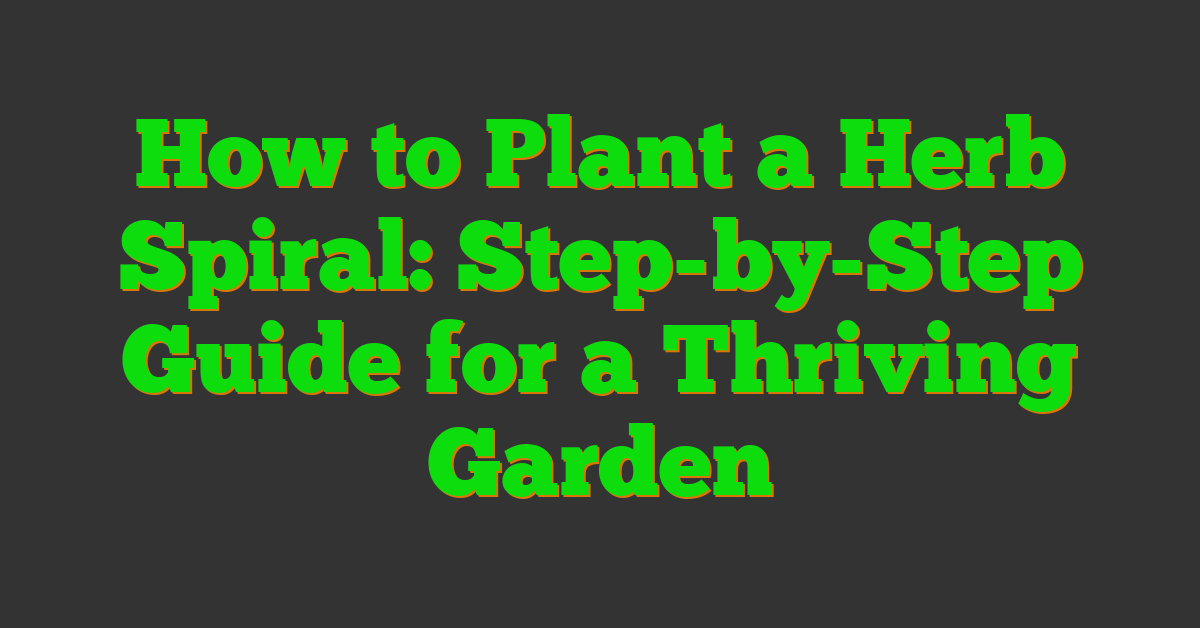Creating a herb spiral is one of my favorite gardening projects. It not only saves space but also adds a beautiful focal point to any garden. I’ve found that with just a little planning you can enjoy a variety of herbs all in one compact efficient design.

Setting up a herb spiral might seem daunting at first but it’s easier than you think. I’ll share some tips and steps that will guide you through the process ensuring your spiral thrives. Whether you’re a seasoned gardener or just starting out you’ll find planting a herb spiral both fun and rewarding.
Benefits Of A Herb Spiral
- Space Efficiency: A compact design allows for multiple plant varieties in a small area, making it perfect for limited spaces.
- Microclimate Creation: Different levels provide varied conditions, supporting diverse herbs that thrive in specific environments.
- Enhanced Aesthetics: Adds visual interest with its unique structure, serving as an attractive focal point in the garden.
- Improved Plant Health: Proper drainage and airflow reduce the risk of diseases, promoting healthier herb growth.
- Resource Optimization: Maximizes soil usage and reduces water waste by utilizing gravity-fed irrigation naturally.
Planning And Designing Your Herb Spiral
Designing your herb spiral starts with thoughtful planning. I focus on size, shape, and the materials I use to ensure a functional and beautiful garden feature.
Size And Shape Considerations
Determining the right size depends on available space and desired capacity. Typically, herb spirals range from 3 to 6 feet in diameter. Shape options include circular, square, or custom designs to fit your garden layout. I consider the microclimates each level will create, ensuring optimal growth conditions for various herbs. Adequate space allows for easy access and maintenance.
Materials Needed
Gathering the right materials is essential for building a durable herb spiral. I use the following:
- Stone or brick: For constructing the spiral walls, providing stability and drainage.
- Wood: As a base framework, offering support and structure.
- Soil: A high-quality mix with good drainage to promote healthy herb growth.
- Gravel: For the base layer, enhancing drainage and preventing weed growth.
- Mulch: To retain moisture and regulate soil temperature.
- Tools: Including a shovel, wheelbarrow, level, and measuring tape for precise construction.
Having these materials on hand ensures a smooth building process and a long-lasting herb spiral.
Choosing The Right Location
Selecting the perfect spot for your herb spiral ensures optimal growth and ease of maintenance. I prioritize areas that receive at least six hours of sunlight daily, as most herbs thrive in full sun. If your garden lacks sufficient sunlight, consider herbs like mint or parsley that tolerate partial shade.
Drainage plays a crucial role in the success of a herb spiral. I choose locations with well-draining soil to prevent waterlogging, which can harm plant roots. To assess drainage, I perform a simple water test: digging a hole and filling it with water to see how quickly it drains.
Accessibility is another key factor. Placing the herb spiral near your kitchen or a water source simplifies watering and harvesting. I also ensure there’s enough space around the spiral for easy maneuvering during maintenance tasks like weeding and pruning.
Additionally, I consider the existing microclimates in my garden. By selecting a spot that naturally accommodates the varying moisture and temperature needs of different herbs, I create an environment where each plant can flourish.
| Factor | Considerations |
|---|---|
| Sunlight | Minimum 6 hours of direct sunlight daily |
| Drainage | Well-draining soil to prevent waterlogging |
| Accessibility | Proximity to kitchen and water sources |
| Space | Sufficient room for maintenance and growth |
| Microclimates | Natural variations in moisture and temperature needs |
Choosing the right location sets the foundation for a thriving herb spiral, making your gardening experience enjoyable and rewarding.
Selecting Herbs For The Spiral
Choosing the right herbs ensures your spiral thrives. I focus on selecting varieties that match the spiral’s microclimates.
Best Herbs For Sunlight
I plant herbs that need at least six hours of direct sunlight:
- Rosemary: Drought-tolerant and aromatic, ideal for sunny spots.
- Basil: Flourishes in warm, sunny conditions and adds vibrant flavor.
- Thyme: Low-maintenance and perfect for full sun with excellent drainage.
- Oregano: Hardy and spreads easily, benefiting from ample sunlight.
- Sage: Prefers sunny areas and contributes a robust taste to dishes.
Herbs For Shaded Areas
- Mint: Thrives in lower light and adds a refreshing taste to beverages.
- Parsley: Grows well in shaded spots and offers versatile culinary uses.
- Chives: Adaptable to partial shade and provide a mild onion flavor.
- Cilantro: Prefers cooler, shaded areas and is essential for various recipes.
- Lemon Balm: Enjoys partial shade and adds a citrusy note to teas and desserts.
Building The Herb Spiral
Constructing a herb spiral requires careful planning and execution. Here’s how I build a sturdy and efficient spiral in my garden.
Step-By-Step Construction
- Choose the Site
I select a location with at least six hours of sunlight and good drainage. Measuring 4 feet in diameter provides ample space for diverse herbs.
- Gather Materials
I gather stones or bricks for the walls, treated wood for the framework, high-quality soil, gravel for drainage, mulch, and essential tools like a shovel and level.
- Prepare the Base
I lay a gravel base about 4 inches deep to ensure proper drainage. This prevents waterlogging and supports plant health.
- Build the Spiral Structure
Starting at the center, I stack stones or bricks in a spiral pattern, ensuring each layer is level. I alternate heights to create the spiral’s characteristic rise and fall.
- Add the Framework
I use treated wood to reinforce the walls, securing them firmly to withstand weather elements. This step adds stability to the spiral.
« Budgeting for a Pergola Installation: Essential Tips to Stay on Track How to Prevent Plant Diseases: Essential Tips for a Thriving Garden »
- Fill with Soil
I fill the spiral with a mixture of compost and potting soil, layering it to accommodate the varying moisture needs of different herbs.
- Plant the Herbs
I arrange herbs according to their sunlight and moisture preferences, placing sun-loving varieties at the top and shade-tolerant ones at the bottom.
- Mulch and Water
I apply mulch to retain moisture and water the spiral thoroughly, ensuring all herbs receive adequate hydration.
Tips For Durable Structures
- Use Quality Materials
I choose long-lasting stones or bricks and treated wood to withstand outdoor conditions and prevent decay.
- Ensure Proper Drainage
Incorporating a gravel base and arranging stones tightly minimizes water accumulation, enhancing the spiral’s longevity.
- Secure the Walls
I reinforce the structure with a sturdy framework, using brackets or screws to keep the walls in place during heavy rain or wind.
- Level Each Layer
I use a level tool for each layer, ensuring the spiral maintains its shape and stability over time.
- Protect from Erosion
I add mulch on top and around the base to prevent soil erosion and support plant health.
- Regular Maintenance
I inspect the spiral periodically, tightening any loose stones and replenishing mulch to maintain its durability and appearance.
By following these steps and tips, I build herb spirals that are not only functional but also stand the test of time in my garden.
Planting And Maintenance Tips
Maintaining a thriving herb spiral involves careful attention to watering, soil care, pruning, and harvesting. Here are the essential tips to keep your herbs healthy and productive.
Watering And Soil Care
Proper watering and soil management are crucial for a successful herb spiral. I ensure consistent moisture levels by watering deeply once a week, adjusting frequency based on weather conditions. For well-draining soil, I use a mix of 60% compost, 30% sand, and 10% perlite. This combination provides necessary nutrients and prevents waterlogging.
-
Watering Tips:
- Water early in the morning to reduce evaporation.
- Use a soaker hose for even distribution.
- Check soil moisture by inserting a finger 2 inches deep; water if dry.
-
Soil Care Tips:
- Add organic mulch to retain moisture and suppress weeds.
- Rotate herbs annually to maintain soil fertility.
- Incorporate a balanced fertilizer once a month during the growing season.
Pruning And Harvesting
Regular pruning and harvesting keep your herbs vigorous and encourage continuous growth. I trim herbs like basil and rosemary regularly to promote bushy growth and prevent legginess. Harvest in the morning when oils are most concentrated for the best flavor.
-
Pruning Tips:
- Use sharp, clean scissors to make precise cuts.
- Remove dead or yellowing leaves promptly.
- Pinch back the tips of herbs to encourage branching.
- Harvest no more than one-third of the plant at a time.
- Cut stems above a leaf node to stimulate new growth.
- Dry or refrigerate excess herbs to preserve their freshness.
By following these watering, soil care, pruning, and harvesting practices, my herb spiral remains a vibrant and productive feature in the garden.
Common Mistakes To Avoid
- Poor Site Selection results in inadequate sunlight or improper drainage, limiting herb growth.
- Ignoring Microclimates causes mismatched conditions, preventing certain herbs from thriving.
- Faulty Construction leads to unstable structures or poor drainage, compromising the spiral’s integrity.
- Overcrowding Herbs restricts airflow and root space, reducing plant health and productivity.
- Using Low-Quality Soil decreases nutrient availability and drainage efficiency, hindering herb development.
- Neglecting Maintenance results in inconsistent watering and unchecked growth, weakening plant resilience.
- Choosing Incompatible Herbs creates competition for resources, causing some herbs to underperform.
- Inadequate Planning produces incorrect spiral dimensions or unsuitable materials, affecting overall functionality.
Conclusion
Creating a herb spiral has been one of the most rewarding projects I’ve taken on in my garden. Watching different herbs thrive in their unique spots brings so much joy and satisfaction. It’s amazing how such a simple structure can transform a garden space, making it both beautiful and functional.
I love how a herb spiral not only saves space but also adds a charming focal point to the garden. The variety of herbs growing together creates a delightful mix of scents and flavors right at my fingertips. Plus, the microclimates within the spiral ensure each herb gets exactly what it needs to flourish.
If you’re looking to add a touch of creativity and practicality to your garden, a herb spiral is definitely worth considering. It’s a project that’s both enjoyable to build and incredibly beneficial in the long run.


![The Healing Herbal Teas Beginners' Guide [All-in-1]: Everything on How](https://m.media-amazon.com/images/I/5133+cfBYtL._SL500_.jpg)













